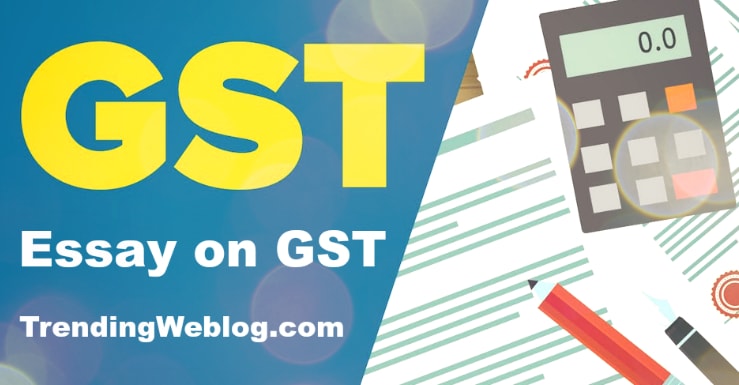Essay on GST in English – Essay on GST for Class 5, 6, 7, 8, 9, 10, 11, 12. Find paragraph, long and short essay on GST India in about 250, 300 words for Students. Learn everything about essay on GST in 300 words, essay on GST in 350 words, essay on GST in 400 words and essay on GST in 1000 words.
Essay on GST

GST Essay in English | Essay on GST INDIA
Essay on GST 300 Words
GST is abbreviated as Goods and Service Tax. It is a very good step taken by our government of India to make a developed country. This system is launched by our honourable Prime Minister Mr Narendra Modi from 1st July 2017. GST is the one tax system which is really helpful for the people. The main aim of this tax system which is really helpful for the people. The main aim of the tax is to reduce black marketing and make easy for the business people to analyze tax.
There are mainly three taxes in GST
Central Good and Service Tax (CGST)
State Goods and Service Tax (SGST)
Integrated Goods and Service Tax (IGST)
GST is divided into two type one is goods and service tax that is abbreviated as SGST and central and service tax which is abbreviated as CGST. Transport of goods comes under integrated goods and service tax which is abbreviated as IGST.
There are four slabs in the GST system. They are 5%, 12%, 18%, 28%. These slabs are divided based on how essential the goods are? Many items of daily need like milk, bread, butter, and health facilities have been exempted from GST. The prices of some items have reduced like coffee, eating in restaurants, confectioneries while prices of some items have increased like cars, air travelling.
Without GST, we have to pay many taxes like VAT, excise duty tax, goods, service, additional excise duty tax, transportation tax etc. It’s enough to pay tax to the retailer when we are buying the goods. So with GST, all these taxes are combined.
GST will help to reduce the corruption related to taxes. It is also very beneficial for the common people to pay only one taxes. By merging all the taxes in one tax, GST is really a one nation one tax system.
Essay on GST 300 Words
Goods and services tax (GST) is an indirect taxation reform which aims at merging most of the taxes reform which aims at merging most of the taxes of centre and state into a single taxation system. It was implemented on 1st July 2017, as 122nd constitutional amendment bill and passed as a law by 101st constitutional Amendment Act. GST is governed by GST council and the chairman of it is Union minister of Finance.
GST is the biggest tax reform in the indirect location structure. Hence, it has removed the cascading effect of various indirect taxes. GST is divided into three parts Central GST, State GST and Integrated GST. It is backed by GST Network which is a fully integrated tax platform to deal with all aspects of GST.
GST has made the system more transparent which has reduced the possibility of tax avoidance and tax evasion. The ease of doing business has improved because of no hidden taxes. Prices of necessity commodities have come down because of the single tax, which has benefited common people. This has increased consumption which helped companies, that in turn helped in the economic growth of the country. Also, the price of a commodity is the same throughout the country.
The difference in the tax rate of different commodities has also increased the price of some articles which has made various business groups and trade unions unsatisfied with GST rates. Also, some states are concerned about its effect on their revenue collection. The lengthy and cumbersome procedure of GST is difficult for common man and business houses to understand.
GST has brought a major change in the indirect taxation system. It is beneficial for consumers, traders and also the government. Though it has few drawbacks, but it should not be the reason to demean a system which has many long-term advantages.
Essay on GST 350 Words
India is transforming rapidly. Many initiative were taken by our government to make our country better and one of such initiative is GST bill. Goods and services tax is a single indirect tax which has respelled all previous tax which were taken by state and central government. It was introduced by one hundred and first constitutional amendment in 2017.
France was the first country to introduce GST in 1954. Across the globe, more than 150 nations have applied GST in their countries like Brazil, Canada, Australia etc have a dual GST taxation system, i.e state GST and Central GST. In the same way, India has implemented total GST. Taxes of Central like Custom Excise duty, Service tax, Additional Excise duty and State taxes like VAT, entertainment tax, Sales tax etc had been merged in a single tax i.e GST.
As it is a consumption-based tax which means the tax should be received by the state in which the Goods and services are consumed and not by the state in which such good are manufactured. After implementing GST, our taxation system has improved, it has created transparency in our taxation system. Though GST complexity our taxes has improved and it has created a single total through which we can easily pay our taxes. It has also reduced the cascading effect of dual taxes which has decreased the price of product and i.e beneficial for customers.
Many economists and experts have predicted that the GST bill will boost up the economy in long run but we see some short-term impact on the economy too. According to the National Council of Applied Economic, it will grow our gross domestic product (GDP) from 0.9% to 1.7%. Due to simple and single tax, it will also promote exports, create more employment opportunity.
In my opinion, GST is history move by our government which has brought major changes in our taxation system by implementing one Nation one tax.
Essay on GST 350 Words
GST was implemented on 1st July 2017 as 101st Constitutional Amendment Bill. Goods and Services Tax (GST) is a reformatory legislation which is a single tax on the supply of goods and services, right from the manufacturer to the consumer. It is the biggest tax reform in the Indirect tax structure. A viable tax regime which is vital for the sustainable economic growth and fiscal consolidation of Indian economy. GST assumes a greater importance in a developing economy like India. GST will remove the cascading effect of various Indirect taxes. We need a transparent, just, equitable and fair taxation system that is easy to administer.
More than 150 countries have successfully implemented GST. In India, more than 60% of the total tax collected is accounted for indirect taxes hence, this reform is very important. Divided into three parts Central GST, State GST, and Integrated GST. GST Council to decide various aspects and tax rates. GST Network for IT infrastructure. GST is a progressive tax i.e. it has a different tax rate for different commodities.
GST will reduce the possibility of tax manipulation, make them more transparent system and benefit the consumers. It will promote ease of doing business. GST will surely increase the number of taxpayers, hence more revenue generation. Some states are concerned about its effect on their revenue collection. Various business groups and trade unions are not satisfied with the GST rates. The lengthy and cumbersome procedure has caused a delay in tax collection. Government is working with all the stakeholders for a smooth operation of GST system. GST rates have been revised for the betterment of people and businessmen.
The government should work effectively to ease the complexity of the present system. Tax rates for essential goods should be monitored regularly. There should be a proper mechanism for tax sharing between states. Just on the basis of some negative aspects, we should not demean a system which has many long-term advantages. GST would give a strong signal to the foreign investors about India’s increased creditworthiness, lesser compliance and procedural costs in the taxation sphere. This tax reform will surely help the Indian economy and boost GDP.
Essay on GST 400 Words
GST (Goods and Service Tax) is defined as any tax on supply of goods and services other than on alcohol for human consumption. GST is destination based consumption tax based on VAT principle. Model GST law was published in July 2016 and a revised Model GST Law was issued in the same year on 26th November. In 1954 France implemented GST. Worldwide, almost 150 countries have introduced GST. Most countries have unified GST system but Brazil and Canada have a dual GST system same as India is going to introduce.
Central taxes such as Central Excise duty, Service tax, Additional Excise duty, Additional Customs duty and Special Additional duty as well as state-level taxes such as VAT or Central Sales tax, Entertainment tax, sales tax, Purchase tax, Entry tax and Octroi and Luxury tax will subsume in GST. The power to make laws in respect of supplies in the course of inter-state trade or commerce will be vested only in the Union Government. With this system States can levy GST on intrastate transactions, including on services. The Centre will levy IGST on the inter-state supply of goods and services. Import of goods will be subject to basic customs duty and IGST.
The GST structure would follow the destination principle. Accordingly, imports would be subject to GST, while exports would be zero-rated. In the case of inter-state transactions within India, State tax would apply in the state of destination as opposed to that of origin. All the existing taxpayers registered under VAT, Service Tax, and Excise are required to furnish the details at GST Common portal for the purpose of migrating themselves into GST regime
After GST Service Tax which is 15% right now will increase to 18%. Even if a supplier of Goods or Services is having turnover below to threshold limit, registration is compulsory in case of interstate supplies. States are allowed to levy the additional rates of 1% to 2% tax on certain commodities, which will defeat the purpose. Despite ONE NATION-ONE TAX policy, one has to register in every state where one has business places.
Removal of tax barriers on the introduction of tax barriers on the introduction of uniform GST across the country with seamless credit will make India a common market leading to an economy of scale in production and efficiency in supply chain. It will expand trade and commerce. Ultimately it will be a great reform for the betterment of the economy and also for the people of India.
Essay on GST 1000 Words
GST most important indirect tax reform across the nation since Independence. It has taken almost 16 years from the date of inception of the idea, formation of a task force, to a passage in Parliament. It represents a Herculean, nationwide, multi-party consensus-building exercise which is finally bearing fruit.
GST is a destination based indirect tax on consumption. It will be levied on all goods and services except liquor for human consumption, petroleum and electricity.
What we have at present – Currently, more than 25 different tax rates on various goods and services are levied by 29 states and the Centre combined. This yields nearly Rs.9 lakh crore as total indirect tax revenues for the nation.
Without GST –
There are multiple points of taxation and multiple jurisdictions. We also have an imperfect system of offsetting credits on taxes paid on inputs, leading to higher costs. Further, there is cascading of taxes — that is, tax on tax.
Firstly, Interstate commerce has been hampered due to the dead-weight burden on Central sales tax and entry taxes, which have no offsets. All this will go once the GST is in place. It will enhance the ease of doing business. Make our producers more competitive against imports.
Secondly, the adoption of the GST is an iconic example of what Prime Minister Narendra Modi has called “cooperative federalism”. It represents a national consensus, an outcome of a grand bargain struck together by 29 States and seven Union Territories with the Central government. The States agreed to give up their right to impose the sales tax on goods (VAT), and the Centre gave up its right to impose excise and services tax. In exchange, they will each get a share of the unified GST collected nationally. The anticipated additional gains in efficiency, competitiveness and overall tax collections are what drove this bargain.
Thirdly, once the GST is in place, it means a unified, unfragmented national market for good and services, accessible to the smallest entrepreneur. Companies need not maintain stock deport to avoid paying interstate taxes. This will free up some capital. All this will add to demand, and also efficiency. The National Council for Applied Economic Research and others have estimated that national GDP growth can go up by one percentage point on a sustained basis.
Fourthly, because the structure of claiming input tax credit linked to having proof of taxes paid at an earlier stage in the value chain, this creates interlocking incentives for compliance between vendor and customer. Because of this inherent incentive, the total taxes paid, and hence collected, may go up significantly. This provides buoyancy to the GST. In fact, a significant part of the black economy will enter the tax paid economy.
Issues of GST
First is the question of the uniform GST rate. The empowered committee of finance ministers uses a concept called “Revenue Neutral Rate” or RNR. The RNR is that uniform rate which when applied will leave all States with the same revenue as before. So no State should lose out by signing up to the GST. But this approach is faulty since unless we try it for a year (or more) we won’t be able to gauge the buoyancy of the GST. In trying to assuage the fears of States, the calculation of the RNR has been loaded by every possible existing tax (like entry tax, octroi, etc.). This has caused the RNR to steadily escalate upward.
The second issue is that the GST is an indirect tax. By their very nature, indirect taxes are regressive because they affect the poor more than the rich. India’s ratio of indirect to direct tax collection is 65:35, which is exactly the opposite of the norm in most developed countries. India’s ratio of direct tax to GDP is one of the lowest in the world, and it badly needs to expand the direct tax net. Only 4 per cent of India pays income tax, but practically all Indians pay indirect taxes in one form or the other. Direct tax rates have been falling, and indirect tax rates rising. For instance, service tax (an indirect tax) used to be 5 per cent in the 1990s and is now more than 15 per cent. The Swachh Bharat cess or frequent increase in excise duty on petrol and diesel are all recent examples of regressive indirect tax. Unless a rate cap is adopted, the GST rate could easily drift higher, further hurting India’s income inequality. To meet their fiscal needs, it is always tempting for governments to tweak indirect taxes higher since the work of expanding the direct tax net is so much harder. This temptation must be curbed with a rate cap.
The third issue is of tax litigation. Approximately Rs.1.5 lakh crore is stuck in litigation related to Central excise and service taxes. On the other hand, the State-level VAT is administered in a way that empowers tax officials to dispose of cases quickly. Disputes involving Central taxes go through an appeal and tribunal process and can drag on for years. But empowered staff under the Sales Tax Commissioner can dispose of valid grievances of State-level VAT payers much faster. This difference is called the “review” versus “revise” approach to tax disputes. It is important that the GST approach leans towards the more efficient State-level model.
The fourth issue in implementing the GST is the governance within the GST Council. It is a de facto council of States, along with representatives from the Union Finance Ministry. It seems that one State will get one vote, irrespective of its size. This seems unfair. An economically larger State, contributing a bigger chunk of the GST pie, should have a greater say.
In Conclusion
The GST is obviously not a panacea for all ills of India’s economy. It is nevertheless a revolutionary and long-pending reform. It promises economic growth and jobs, better efficiency and ease of doing business, and higher tax collection. We hope that its imperfections and potential pitfalls will be sorted out as we roll it out.
Learn everything about “Essay on GST”
Essay on GST in Hindi, Essay on GST, Essay on GST 300 words, Essay on GST 350 words, Essay on GST 400 words, Essay on GST 1000 words, New Essay on GST, Essay on GST for SSC.







